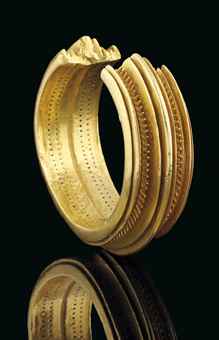Un arqueólogo siempre dirá lo mismo, que si el Tesoro de Villena es de valor incalculable, que si no tiene comparación, que estas cosas simplemente no se pueden vender...
Pero el tema es que ha pasado algo recientemente que nos puede dar una idea de su valor en ciertos mercados (es una pena, pero para las colecciones y caprichos privados esta cosas sí tienen un precio). Este pasado jueves, 2 de mayo, se vendió en la sala Christie's de Londres el brazalete de Portalegre.
 |
| Brazalete de Portalegre (Portugal) Mmmmm.... ¿No me suena esto de algo? |
Un Alicantino, Murciano, Albaceteño o Valenciano que le eche un ojo a este brazalete, juraría y perjuraría que se trata de uno de los famosos brazaletes del Tesoro de Villena. Y es que, observándolo, es muy difícil distinguirlo de las piezas villeneras. De echo, el propio Soler sugirió que este brazalete y el de Estremoz provienen en realidad de Villena, de los orfebres del Cabezo Redondo, aunque bien podrían haber sido hallados aquí y haber acabado en Portugal (Portalegre y Estremoz son pueblecicos de nuestros vecinos vendedores de toallas). Son de la misma época que los nuestros y están hechos de forma idéntica.
El problema es que en Portugal les faltó su versión lusa de nuestro José María Soler y los brazaletes acabaron en manos privadas. El de Portalegre se acabó malvendiendo en Suiza en 1979 (¿Suiza? Mmmmm... Sin comentarios....) y ahora se ha vendido en Christie's por el "módico" precio de 517.875 libras (¡¡¡ Unos 600.000 € !!!).
Descripción del Brazalete en la subasta (no dudan en informar de su relación con Villena):
Lot Description
A CELTIC SOLID GOLD BRACELET
IRON AGE, CIRCA 1000 B.C.
With central ridge flanked on each side by a shorter, sharper ridge, and then a line of 'cones', with a line of small, square piercings on either side, the outer edges each with another triple set of ridges, the ridges, cones and piercings extending right along the extent of the bracelet, with no distinct terminals, the interior surface with central longitudinal groove, flanked by a double row of small, square piercings
3¾ in. (9.5 cm.) diam. max.; weight 599.3 g.
Special Notice
VAT rate of 5% is payable on hammer price and at 20% on the buyer's premium.
Provenance
Portuguese private collection, Switzerland, acquired prior to 1979; thence by descent to the present owners.
Lot Notes
PUBLISHED:
M. Cardozo, Joalharia Lusitanian, Conimbriga, vol. 1, Coimbra, 1959, pp. 13-27.
J. M. Soler Garcia, El Tesoro de Villena, Madrid, 1965, p. 53 no. 5, pl. XXIII, 1.
This fine, heavy gold bracelet dates from the dawn of the European Iron Age, around 1000 B.C., and is perhaps the only example of its type to still be in private hands. It was found in Portalegre in Portugal and is of a type known from across the Iberian Peninsula, with another single example from nearby Estremoz in Portugal (The National Archaeological Museum of Madrid, Spain, inv. no. 35651), and the famous group from Villena near Alicante in South East Spain (now in the Museo Arqueológico, Villena). The Villena treasure, discovered in 1963, contained more than nine kilos of gold objects in total, including twenty-eight bracelets, many closely related to the present example.
The various bracelets of this type show related decorative schemes mostly involving longitudinal ridges, lines of raised 'cones' and piercings. The design seems entirely geometric without figural or representational purpose, as are the ridge, cone and pierced designs on the other bracelets of the type.
Iron was just beginning to come into use around 1000 B.C., bringing two huge benefits for the goldsmith. The development of furnaces capable of achieving the high temperatures necessary for iron production also provided the craftsman with the technology to melt larger masses of gold than before. The iron itself could be used to make tools to cut and shape gold that were sharper and more durable than the earlier copper alloy implements. The net result of this leap in technical skills is perfectly shown by this bracelet. It is made from a single piece of gold weighing almost two-thirds of a kilo, and the intricate and regular design was cleanly cut and shaped with a repertoire of sharp metal tools. The starting point for the bracelet was a cast rod or plate of gold, possibly plain, possibly with the basic contours of the ridges cast in. This was then shaped, cut and pierced with sharp iron tools, the marks of which can clearly be seen under magnification. The work was carried out with great skill and precision. The similarities between this bracelet and those from Villena and Estremoz raise the question as to place of production and whether there was just one workshop responsible.
The gold itself is of high purity as can be seen by its colour. High purity meant that the gold was sufficiently soft and malleable to be shaped. Analysis of the similar bracelets from Villena revealed that the majority were about 90-95 gold, with silver being the only other major element present. This represents around 22 to 23 carats in modern terms. The Iberian peninsula has various sources of gold and we can perhaps assume a local source for the gold used here, which was used as found, with neither refining nor alloying.
Y todo eso por un sólo brazalete (que los guiris catalogaban sin mucha idea como pieza "celta", que allí eso vende mucho). Sólo nos hace falta sacar la calculadora y hacer un par de aproximaciones para el equivalente a las 60 piezas del Tesoro de Villena. Así que... ¿Por cuánto se vendería nuestro incalculable Tesoro en Londres?



No hay comentarios:
Publicar un comentario